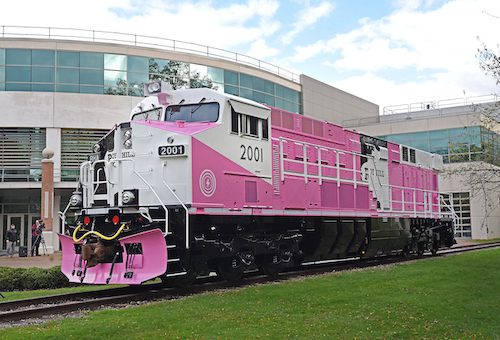The rivalry between Western Australian mining billionaires Andrew Forrest and Gina Rinehart is legendary, heightened today by the fact that climate-sceptic and renewables-doubter Rinehart appears to have beaten Forrest at his own electric game.
Rinehart was not in Pennsylvania this week to take delivery of a pink, electric locomotive that is destined for her Roy Hill iron ore mine, but her presence was no doubt felt, given she was “instrumental” in getting the project off the ground, says Hancock Prospecting CEO Gerhard Veldsman.
The train is due to start operations in the Pilbara in 2024, part of Roy Hill’s efforts to cut costs, if not to join the other major iron ore miners in their push to zero emissions mining.
The train is bright pink to celebrate breast cancer awareness month, and electric to do exactly the thing that Forrest’s proposed Infinity Train is supposed to do: use regenerative braking to charge a battery on the way to the port, enough to get the train back to the mine.
Forrest vs Rinehart
Fortescue started working on its “world-first” Infinity Train last year after buying a UK battery engineering company, saying it could be on tracks come 2024. The company told RenewEconomy earlier this year the project was still in the study phase.
In the meantime, Rinehart has contracted American rail giant Wabtec to build Roy Hill a fully electric locomotive with a 7 megawatt hour (MWh) battery – a feat that both companies called “the world’s first 100 per cent battery-powered, heavy-haul locomotive for mainline service”.
Although it might be a world first train for miners, it’s not going to be uncommon, given other Pilbara miners also have orders in, also for delivery in later 2023/2024, for the same locomotive.
Last year BHP said it would trial four battery electric locomotives, two from Caterpillar company Progress Rail, and another two from Wabtec. Deliveries were expected in late 2023.
And Rio Tinto also bought four of the Wabtec 7MWh FLXdrive locomotives, for delivery next year as well.
Free transport
Based on the route and company’s rail operations, the FLXdrive is expected to provide a double-digit percentage reduction in fuel costs and emissions per train – neither company responded to queries on exactly how much.
Last year Fortescue estimated that electrifying its 16-train fleet could save up to 82 million litres of diesel a year.

“The technological smarts that have gone into the development of the loco makes it well suited for our rail network,” Veldsman says.
“By using regenerative braking, it will charge its battery on the 344 kilometre downhill run from our mine to port facility and use that stored energy to return to the mine, starting the cycle all over again.”
The way the locomotive will be used will make the full train convoy a hybrid electric-diesel consist. A ‘consist’ is the number of locomotives needs to move a full train – locomotives and coaches or wagons.
Today, Roy Hill uses four Wabtec diesel-electric locomotives in a consist to pull trains that are typically 2.7 kilometres long. Adding the electric locomotive will reduce the number of diesel locomotives required for one consist.










